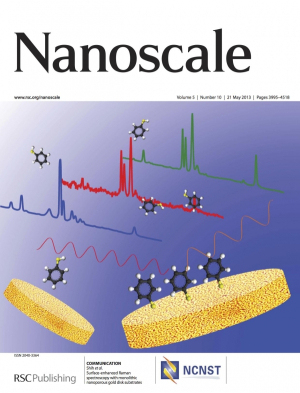Research from the Cullen College of Engineering that promises to drastically improve molecular sensing technology was featured on the cover of a recent issue of the scientific journal Nanoscale.
The work was conducted by electrical and computer engineering assistant professor Wei-Chuan Shih. Shih’s research involves an advance to a molecular detection technique known as surface-enhanced Raman spectroscopy, or SERS, and could boost everything from environmental monitoring to medical diagnostics.
In standard Raman spectroscopy, a laser is shined on an area that is believed to contain unknown molecules. How that laser light scatters, as evidenced by its change in color, can reveal whether and what kind of molecules are present.
In surface-enhanced Raman spectroscopy, the sample being studied is placed on a surface with plasmonic properties. Essentially, when a laser is shined on such a surface, it creates an enhanced electrical field. This field in turn enhances the ability of nearby molecules to scatter the laser light. As a result, a smaller number of molecules can generate more scattered light, resulting in improved detection sensitivity.
Existing SERS substrates consist of nanostructures or nanoparticles made of noble metals such as gold or silver. They have small surface coverage, produce highly variable results and have small active surface areas. Shih’s new SERS substrate, however, features a surface area many times larger and thus an increased number of sensing “hot spots.”
Shih’s advance centers around a hierarchical gold nanostructure – nanoporous gold disks each measuring 500 nanometers (nm) in diameter and 75 nm thick with an internal porous network 7 nm in diameter. The nanofabrication of this structure is carried out in the lab of Jack Wolfe, electrical and computer engineering professor and a co-author of the paper. “Jack’s expertise and capabilities in nanofabrication are essential to make this unique hierarchical nanostructure,” said Shih.
The synergy between the disk shape and the internal pores, he said, drastically improves the ability to sense nearby molecules. Exactly how, though, is an intriguing scientific question.
“I think the magic arises from plasmonic coupling between the disk shape and the nanopores. You don’t see this improvement in a uniform nanoporous thin film,” Shih said. “The cross-length scale plasmonic coupling, if proven true, would be a new discovery. Our nanoporous gold disk provides a unique platform to unravel this. We have obtained evidences to support our interpretation and are preparing a manuscript. We have also achieved detecting a few DNA hybridization events on this platform as described in another manuscript in preparation. These new results have recently been presented at an ECI conference: Advances in Optics for Biotechnology, Medicine and Surgery XIII.”
Besides intriguing science, this SERS substrate has an enhancement factor larger than 100 million.
“If you need 100 million molecules in order to sense them using standard Raman spectroscopy, that’s your detection limit and you cannot see less than that,” Shih said. “With this technology, you can go from needing those 100 million molecules to being able to see just one. Your detection limit is improved.” A standard commercial SERS substrate, he added, has an enhancement factor of 1 million.
In addition to being more sensitive, this substrate has several other benefits. The variability among the gold disks is low, yielding for consistent results from one test to another. What’s more, the disks on the substrate can be cleaned with water or even a bath of sulfuric acid, allowing the sensing surface to be used in harsh environment or to be regenerated.
